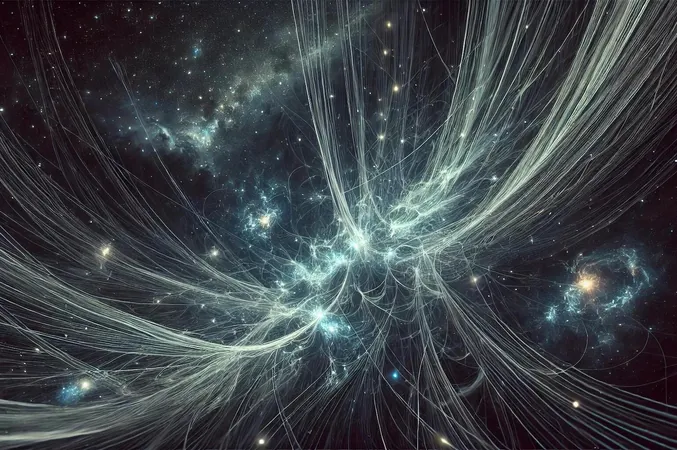
Astrophysicists Make Breakthrough in Search for Cosmic Strings
2025-01-01
Author: Jacob
Astrophysicists Make Breakthrough in Search for Cosmic Strings
In an exciting development that could reshape our understanding of the universe, astrophysicists have reportedly made the first-ever detection of cosmic strings, enigmatic structures predicted in the aftermath of the Big Bang. This revelation from the Indian Institute of Astrophysics has sent shockwaves through the scientific community and reignited interest in one of cosmology’s most fascinating theories.
The Birth of Cosmic Strings
The birth of our universe is a tale marked by extreme conditions and dramatic transformations, beginning with the Big Bang—a cataclysmic explosion that laid the groundwork for space and time. In the immediate aftermath, during a minuscule fraction of a second, the universe underwent a phase transition in its quantum field, theorized to have created cosmic strings. These hypothetical, one-dimensional structures are believed to arise from symmetry-breaking processes during the cooling of the universe.
Historical Context
Cosmic strings were first proposed in the mid-1970s, notably by theoretical physicist Tom W. B. Kibble. He suggested that as the universe expanded and cooled, it could form defects in spacetime similar to imperfections found in crystals. Although once overshadowed by the rise of inflationary models, interest in cosmic strings resurfaced in the 21st century, particularly due to their connections to string theory and potential to generate detectable gravitational waves.
Recent Findings
The recent findings by the Indian researchers, shared in the Bulletin de la Société Royale des Sciences de Liège and available on arXiv, focus on a significant cosmic string candidate labeled CSc-1. The excitement arises from their analysis of two bright galaxies—SDSSJ110429.61+233150.3—which appear to be gravitationally lensed. However, the researchers propose that a cosmic string, rather than a conventional galaxy cluster, could be the lensing agent.
Implications and Future Research
Their simulations suggest that the alignment and spectra of these galactic entities indicate they may be mirror images caused by the gravitational influence of a cosmic string. Despite the potential implications, the researchers acknowledge uncertainties remain. They emphasize the need for further investigation, advocating for observations using advanced telescopes, like the Devasthal Optical Telescope located in Nainital, India.
The Importance of the Discovery
This groundbreaking study is not just an academic pursuit; it holds the promise of deeper insights into the universe’s early moments and the fundamental forces that shaped it. If cosmic strings are confirmed, they could provide unique observational signatures of the high-dimensional theories posited in modern physics.
Conclusion
As scientists sift through this tantalizing data, the quest for definitive proof continues. Will this discovery mark a new chapter in cosmic exploration, or will cosmic strings drift back into the realm of theory? Only time will reveal the true significance of this extraordinary finding. Stay tuned as the universe continues to unveil its mysteries!



 Brasil (PT)
Brasil (PT)
 Canada (EN)
Canada (EN)
 Chile (ES)
Chile (ES)
 Česko (CS)
Česko (CS)
 대한민국 (KO)
대한민국 (KO)
 España (ES)
España (ES)
 France (FR)
France (FR)
 Hong Kong (EN)
Hong Kong (EN)
 Italia (IT)
Italia (IT)
 日本 (JA)
日本 (JA)
 Magyarország (HU)
Magyarország (HU)
 Norge (NO)
Norge (NO)
 Polska (PL)
Polska (PL)
 Schweiz (DE)
Schweiz (DE)
 Singapore (EN)
Singapore (EN)
 Sverige (SV)
Sverige (SV)
 Suomi (FI)
Suomi (FI)
 Türkiye (TR)
Türkiye (TR)
 الإمارات العربية المتحدة (AR)
الإمارات العربية المتحدة (AR)